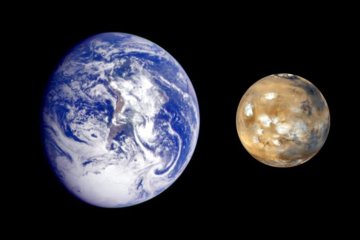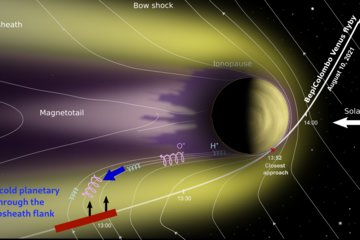All genres
21.
Journal Article
Faculae Cancel out on the Surfaces of Active Suns. The Astrophysical Journal 934, p. L23 (2022)
22.
Journal Article
Predictions of Astrometric Jitter for Sun-like Stars. III. Fast Rotators. The Astrophysical Journal 934, p. 146 (2022)
23.
Journal Article
Predictions of Astrometric Jitter for Sun-like Stars. III. Fast Rotators. The Astrophysical Journal 934, p. 146 (2022)
24.
Journal Article
Solar cyclic activity over the last millennium reconstructedfrom annual 14C data (Corrigendum). Astronomy and Astrophysics 664, p. C3 (2022)
25.
Journal Article
Superflares on solar-like stars. A new method for identifying the true flare sources in photometric surveys. Astronomy and Astrophysics 668, p. A167 (2022)
26.
Journal Article
Reconstructing solar irradiance from historical Ca II K observations: I. Method and its validation. Astronomy and Astrophysics 656, A104 (2021)
27.
Journal Article
Forward modelling of Kepler-band variability due to faculae and spots. Monthly Notices of the Royal Astronomical Society 504 (4), pp. 4751 - 4767 (2021)
28.
Journal Article
Modelling the evolution of the Sun's open and total magnetic flux. Astronomy and Astrophysics 650, A70 (2021)
29.
Journal Article
On the size distribution of spots within sunspot groups. Astronomy and Astrophysics 652, A9 (2021)
30.
Journal Article
Predictions of Astrometric Jitter for Sun-like Stars. I. The Model and Its Application to the Sun as Seen from the Ecliptic. The Astrophysical Journal 908 (2), 223 (2021)
31.
Journal Article
Predictions of Astrometric Jitter for Sun-like Stars. II. Dependence on Inclination, Metallicity, and Active-region Nesting. The Astrophysical Journal 919 (2), 94 (2021)
32.
Journal Article
Predictions of Astrometric Jitter for Sun-like Stars. II. Dependence on Inclination, Metallicity, and Active-region Nesting. The Astrophysical Journal 919, p. 94 (2021)
33.
Journal Article
Modeling Stellar Ca ii H and K Emission Variations. I. Effect of Inclination on the S-index. The Astrophysical Journal 914 (1), 21 (2021)
34.
Journal Article
Modeling Stellar Ca II H and K Emission Variations. I. Effect of Inclination on the S-index. The Astrophysical Journal 914, p. 21 (2021)
35.
Journal Article
Solar cyclic activity over the last millennium reconstructed from annual 14C data. Astronomy and Astrophysics 649, A141 (2021)
36.
Journal Article
The relationship between bipolar magnetic regions and their sunspots. Astronomy and Astrophysics 654, A28 (2021)
37.
Journal Article
Inflection point in the power spectrum of stellar brightness variations: II. The Sun. Astronomy and Astrophysics 636, A69 (2020)
38.
Journal Article
Global temperature modes shed light on the Holocene temperature conundrum. Nature Communications 11 (1), 4726 (2020)
39.
Journal Article
Modelling solar irradiance from ground-based photometric observations. Journal of Space Weather and Space Climate 10, 45 (2020)
40.
Journal Article
Historical solar Ca II K observations at the Kyoto and Sacramento Peak observatories. Journal of Physics: Conference Series 1548 (1), 012007 (2020)











